Index Town Walls Climbing Guide (2023): Washington’s Top Crag

Published on: 08/24/2023
Towering granite walls, mossy forested paths, and jagged mountain vistas… Index, Washington is a stunning place to simply be, let alone to climb. You’ll find cracks, bolted faces, and a rich history of hard free climbing at this classic spot.
This sport and trad climbing area is frequented by many Seattle area climbers. It may well be the best climbing in Washington state.
Location
Coordinates: 47.823975,-121.560794
Index is located in Central Washington, halfway between Seattle and Leavenworth. Granite faces surround the tiny town of Index (population: 156), which is nestled along the North Fork of the Skykomish river. Don’t expect to find a lot of services in town– the Index general store has some basic groceries and snacks, but plan to do the bulk of your grocery shopping in a larger town. There’s no gas station, so make sure you fill up before arriving.
Trains are an integral part of Index: a railroad track lies between the road and the climbing, meaning that you have to cross the tracks on every approach. Trains come through several times daily, and you might have to yell extra loud if you’re trying to communicate to your belayer while one speeds by below!
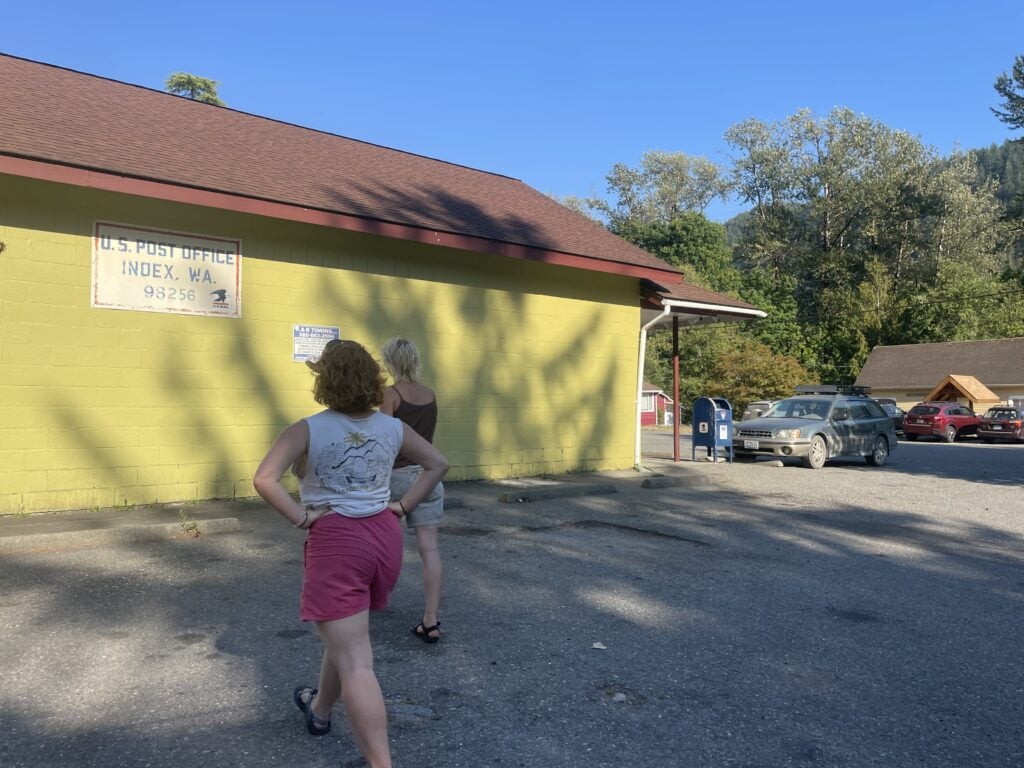
Why Index?
The Pacific Northwest is a great place to be in the summer, and Index is no exception. Temperatures tend to be mild and due to the thick canopy of trees, there’s lots of shaded climbing.
But it’s not just the cool temps that make Index a summer hotspot. In addition to the extremely high quality of the rock, the crags here have a long history in the climbing community, starting in the 1950s when climbers began to access the Yosemite-esque cliffs. Index climbers then, including legends like Fred Beckey, were largely focused on aid climbing. Free climbing didn’t really begin until the 70s, and route development skyrocketed in the 80s.
As more and more free ascents were made over the next few decades, controversies arose. In the 1980s, Todd Skinner was working the first pitch of City Park (13d/8b), a line that had never been freed before. The locals didn’t like the modern climbing ethic, where projecting and hangdogging flourished. So they tried to sabotage his redpoint by pouring railroad grease on the crack. Undeterred, Skinner used a blowtorch to burn off the grease, and sent the next day.
Peter Croft climbed at Index in the 80s too, climbing classic pitches such as Iron Horse (5.11d/7a). In the 90s, new routes continued to be developed, especially sport routes, and the spot now has a combination of both.
Before climbers, Index was a mining town. Before that, the Skykomish Native American people made their home in these Washington woods and fished in the Skykomish river.

Types of Climbing
Index has it all: there’s high-quality sport climbing, trad climbing, and bouldering, with a mix of single and multi-pitch routes. It’s similar in style to Yosemite and Squamish, and is most known for its crack climbing, but the bolted faces and slabs are excellent too. The anchors are all bolted, making it easy to do only part of a multi-pitch, or try an easier first pitch of a challenging route.
Although there are some boulders scattered throughout the woods, the concentration is relatively low. I wouldn’t go to Index for the purpose of bouldering, but if you come for the roped climbing you might find yourself hopping on a boulder or two.
The rock is high-quality granite, and tends to be vertical or less than vertical. There are some steeper, more athletic pitches, such as Tommy’s Sandbox (11-). But generally, expect to use technical footwork, small holds, and of course, lots of jamming skills. Slab technique comes in handy here!
Since the climbing is often low-angle, Index is a place where your legs can get more tired than your arms (hopefully you’ve been doing your calf raises). Instead of sustained endurance climbing, many of the routes at Index are characterized by tricky sections separated by rests. There’s also lots of stemming, so don’t be surprised if you find yourself shaking out your quads (hopefully you’ve been doing your squats).
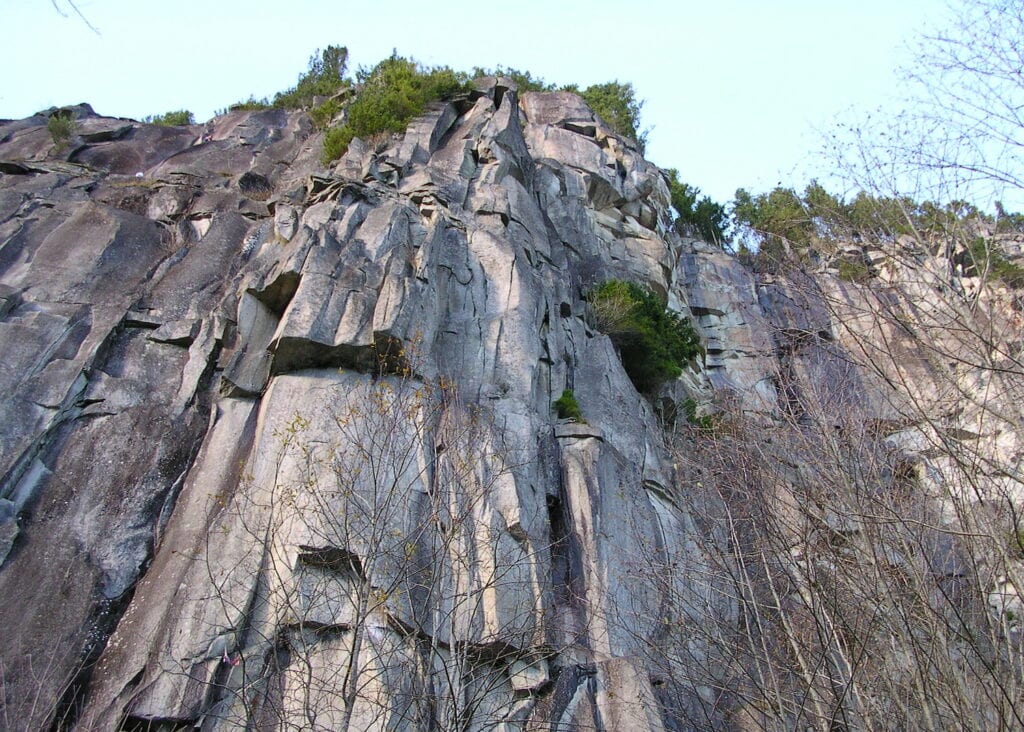
Racking
Although the routes tend to be well protected, the non-splitter nature of the cracks means the gear is less straightforward than areas like Indian Creek. In general, many routes wander from side to side and thus require a decent amount of alpine draws. There’s not a ton of wide stuff, so if you don’t own big cams like 5s and 6s you’ll be OK on most routes. Beyond that, the gear varies for each pitch, but climbers leading trad routes here should have a good understanding of protecting cracks that are less than straightforward.
Levels
Index is notorious for its difficulty—the routes range from 5.6/4b to 5.13/8b. There’s definitely no shortage of hard routes, but there are moderate climbs, too, with over 200 pitches of 5.10. There aren’t as many routes below this level. However, if you’re a 5.9 leader, you’ll be able to climb classics like Senior Citizens in Space (5.7+/4c) and Godzilla (5.9/5b).
The grades in Index have a reputation for being hard, and many climbers will find this true. Compared to areas like Red Rocks or Squamish, on average the climbs at Index feel difficult for the grade.
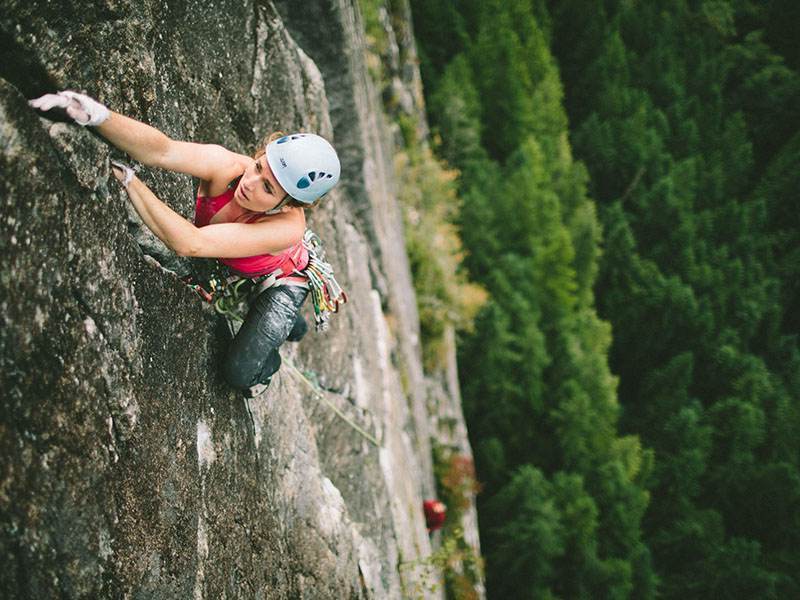
Some of this can be attributed to the style. If you’re new to the area, it will likely take you a little while to get used to trusting your feet and using good technique on confusing terrain. But it’s also true that some of the routes are just tough!
It also depends on when a climb was established: some of the newer routes, like the multi-pitch Golden Road may feel on par with other areas. In contrast, the Amphibian was established many years ago and feels (at least it did to me) much harder than 11b/6c, which is the grade it gets on Mountain Project.
Index is a place to climb high-quality routes in a beautiful setting, but it’s not the place to push grades.
Most popular areas
Here’s a few high-quality climbing areas to check out on your trip.
Private Idaho
This cliff is a good place to find some of the easier climbs in Index, such as Wild Turkey (5.7/4c), Senior Citizens in Space (5.7+/4c), and Battered Sandwich (5.9/5b). There’s some good 5.11 routes too, like the bolted arête Spineless (5.11a/6b+) and I Am In Top a Shader (5.11d/7a), which has a mix of bolts and gear. Many of the routes at Private Idaho can also be toproped by scrambling around to the right.
Lower Town Wall
Main Wall
With easy access (a five minute approach!) and a high concentration of quality routes, the Main Wall at Lower Town Wall is one of Index’s crowning jewels. Godzilla is a fun 5.9/5b, and you can continue up the second pitch of City Park (10b/6a) into the uber-classic 10d/6b Slow Children. The Lower Town Wall is also home to some fabulous single pitch cracks, namely Tatoosh (10b/6a) and Thin Fingers (11a/6b+). Other climbs to check out include Princely Ambitions (5.9/5b) and Breakfast of Champions (5.10a/5c). If 5.11 is in your grade range, Japanese Gardens (5.11+/7a) is a sustained four pitch climb with quality rock all the way up. Alternatively, you can start as for Japanese Gardens, but trend right into the 5.12 testpiece corner Stern Farmer.
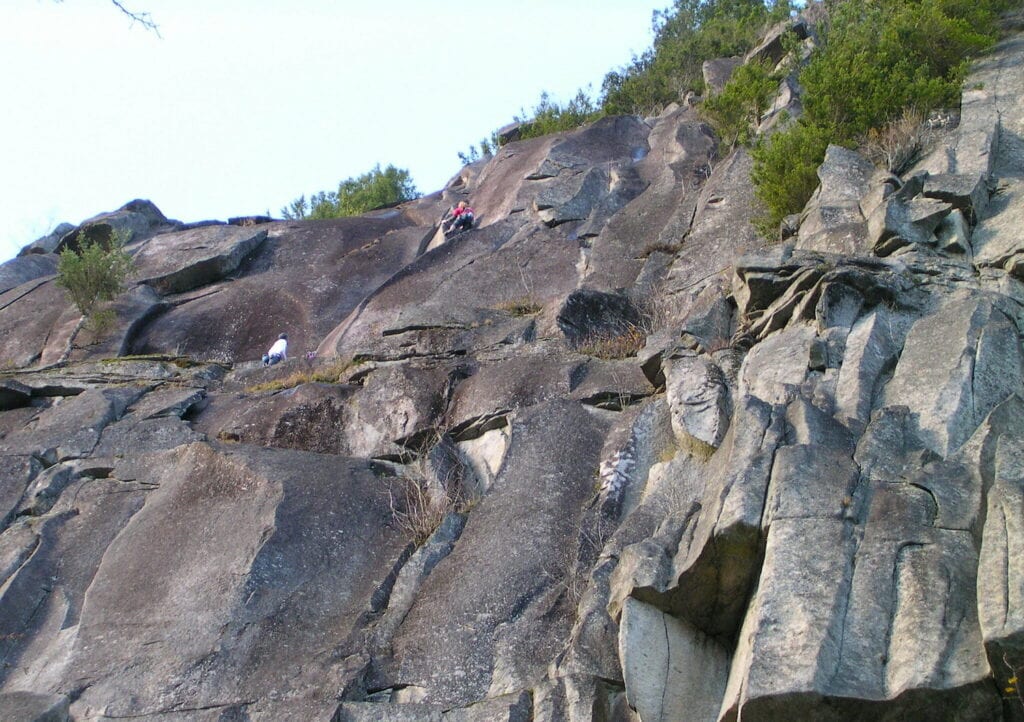
The Country
To get to The Country, keep walking past the Main Wall section of Lower Town Wall. The Country is a great place for the 5.11-5.12 leader, with a variety of high quality sport routes like Climax Control (5.11b/6c), Wham (5.11c/6c+), Fifth Force (5.12/7b) and Kite Flying Blind (5.11c/6c+, two pitches). If you’re looking for something easier, you can lead Mourning Star (5.8/5a) and set up a toprope on Zoom, a fun but difficult to protect 5.10d/6b.
Beetle Bailey Slab
The Beetle Bailey Slab is part of the Lower Lump area– another spot with a five minute approach and good shade. This wall has a plethora of easier climbs, many of which are bolted, such as Flying Salamanders (short) (5.7/4c), Smilodon Fatalis (5.8+/5a), and Behind the Tombstone (5.9/5b). If you want to step in up a bit, Ride the Lightning (5.10c/6a+) is a fantastic four pitch climb– it’s mostly bolted, but you need a few pieces of gear to protect some sections.
Great Northern Slab
Of all the crags in Index, this might be the best place for new trad climbers to set foot. It’s a good spot to spend a cold day, as it gets lots of sun. There’s lots of easier trad climbs, such as Pisces (5.6/4b) or Great Northern Slab (5.7/4c).

Practical Information
How to get there
The town of Index is a couple of miles off Highway 2. If you’re coming from the East, you’ll cross Stevens Pass before turning right onto Index-Galena Road. If you’re coming from the West (i.e. Seattle area), it’s a left turn onto the road several miles after the town of Gold Bar.
After making the turn off the highway, drive for 0.9 miles before turning left onto 5th Street and crossing a bridge, where you’ll see the general store. Where to park depends on which wall you’re heading for, but in general, you want to drive straight through town. Turn left on Index Ave and cross the train tracks. Follow the road as it turns left, then right, then straightens out. To access many of the crags you’ll want to park somewhere along this road– lots and pullouts are available. You’ll see the steep cliffs on the north side of the railroad tracks.
Where to stay
The primary camping spot for climbers is a parking lot called the Wagon Wheel, which is a large pullout on the left side of the road a few hundred feet before the parking lot for the Lower Town Wall. If you park here, you can sleep in your vehicle, as many do, or you can set up camp down by the river.
There are limited campsites by the river, but if you manage to snag one it’s quite a sweet spot. If you’re sleeping in your car and don’t have a site, you can still walk down to the shore for sunbathing and swimming.
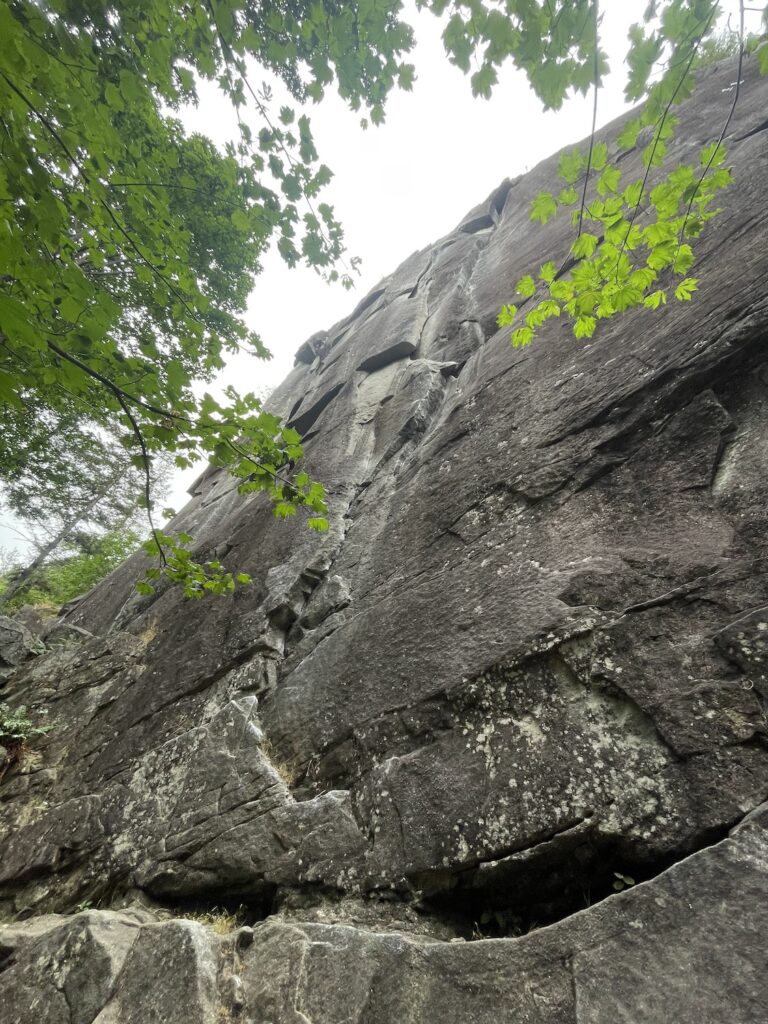
If you decide to camp here, make sure you have a plan for water and trash, as these services aren’t available at the Wagon Wheel. There are a couple of Porta Potties, and there’s also an outhouse on the way to the Lower Town Wall (across the railroad tracks).
If you come to Index alone looking for partners, the Wagonwheel is probably your best bet! It’s a social spot, and people are usually hanging out in the parking area, cooking or trading beta.
If you don’t want to camp, there are AirBnb and hotel options. The historic Bush House Inn has been a part of Index since 1898, and they offer hotel accommodations in addition to food, coffee, and Wifi.
Recommended resources and other tips
As more climbers visit Index, it’s important to treat the place well in order to maintain access. Don’t litter, and be respectful with music and dogs. The Washington Climbers Coalition works to take care of climbing at Index — learn more here.
Companies like NCMG offer guiding services in Index, a good option if you don’t want to figure things out yourself. If you want to get a guidebook, The Index Town Walls by Climbing House contributor Chris Kalman and Matty Van Biene should have you covered.
Index granite is tough on the fingers, and you may find that your fingertip skin gets thin quickly. I’d recommend not climbing more than two days in a row so that your skin has time to recover!
When your skin is thin, there’s lots of other things to do. Index’s local outdoor companies offer river activities like kayaking and rafting. There’s hiking trails too, and the river is always a great spot to hang out.

Shade information
The majority of the walls get shade midafternoon, a good thing to keep in mind when deciding when and where to climb. Single pitch climbs at walls such as Rattletale Wall are shady all day, since tall trees that surround the crag block the sun until it goes behind the wall. The Inner Walls is another spot with all-day shade.
If you find yourself in Index in the winter, a sunny day can be quite pleasant. Many of the cliffs, especially the multi-pitch routes, do get lots of sun so cold winter temperatures can be pleasant on the wall.
FAQs
The climbing at Index is primarily bolted faces and technical, varied crack climbs.
Although there are plenty of moderates, it’s not the best spot for total beginners. The hard grades and tricky movement mean that it’s best to have some outdoor climbing experience under your belt before visiting this classic area.
A standard rack for this spot includes doubles of cams from .3 to 3 as well as nuts, alpine draws, and slings for an anchor. Of course, this will vary greatly from climb to climb.
References
Index — Thumbnail History (retrieved on 08/17/2023)
HistoryLink
https://www.historylink.org/file/9143
Index Climbing (retrieved on 8/15/2023)
Mountain Project
https://www.mountainproject.com/area/105790635/index
Index: The Trad Climbing Oasis That’s Shaking Off Its Moss (retrieved on 08/19/2023)
57 hours
https://57hours.com/review/index-trad-climbing/
Five Reasons Not to Climb at Washington’s Index Town Walls (retrieved on 08/17/2023)
Climbing Magazine
https://www.climbing.com/places/climbing-washingtons-index-town-walls/
Index (retrieved on 08/15/2023)
Washington Climbers Coalition
https://washingtonclimbers.org/index.php/2015/10/13/index/
Index Club (retrieved 08/19/2023)
Climbing Magazine
https://www.climbing.com/news/index-club/
